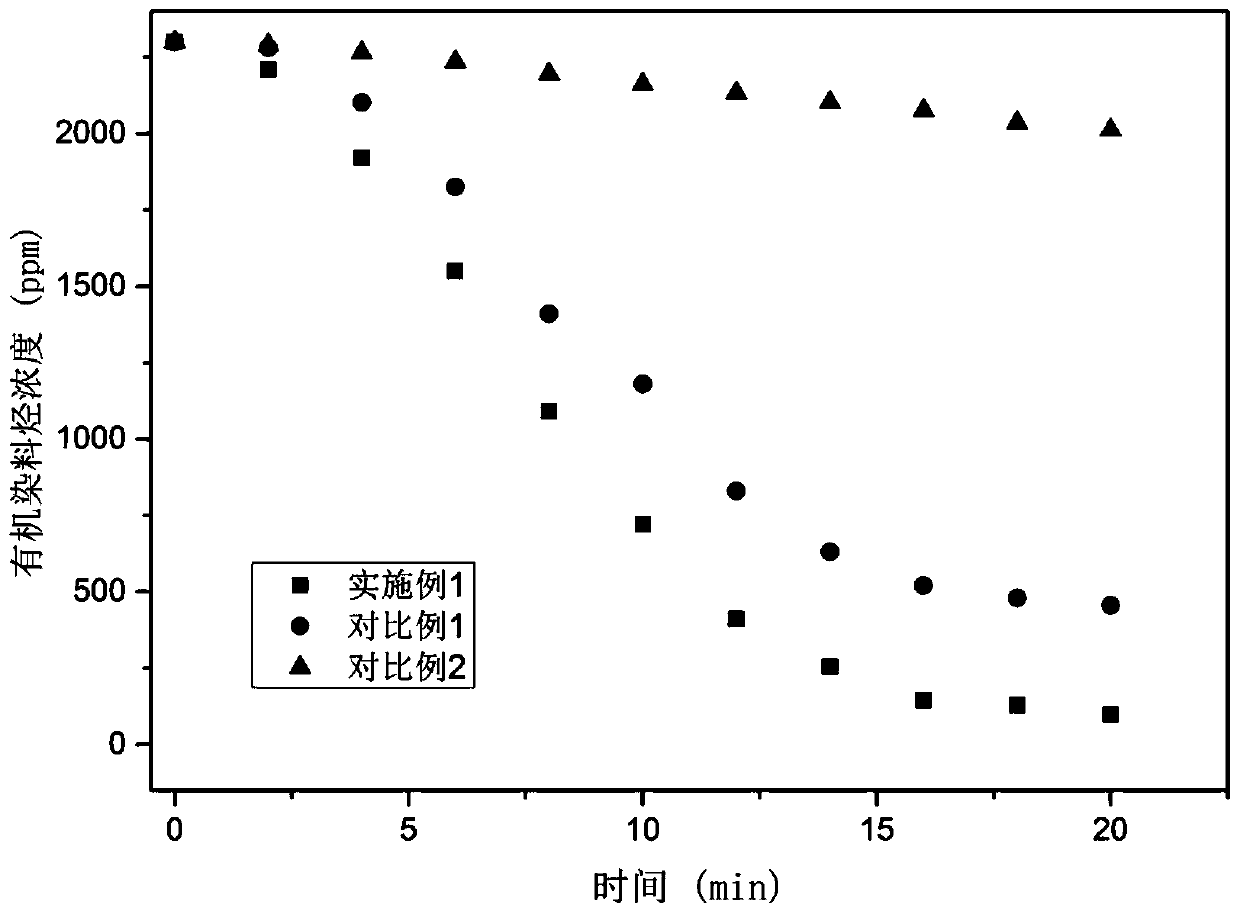Method for enhancing photodegradation of organic dyes in wastewater by acetaldehyde
A technology of organic dyes and photodegradation, applied in chemical instruments and methods, water pollutants, special compound water treatment, etc., can solve the problems of poor recycling performance and low photocatalytic efficiency, and achieve improved photocatalytic effect and improved decomposition Efficiency, good photosensitivity effects
- Summary
- Abstract
- Description
- Claims
- Application Information
AI Technical Summary
Problems solved by technology
Method used
Image
Examples
Embodiment 1
[0035] A method for acetaldehyde-enhanced photodegradation of organic dyes in wastewater, the method comprising the following steps:
[0036] (1) Micro-oxidation treatment: Add 0.042% hydrogen peroxide of the wastewater quality to wastewater containing 2300ppm of organic dye methylene blue, and stir for 45 minutes to obtain oxygenated wastewater;
[0037] (2) Preparation of pre-treatment liquid: After adding 800 ppm of acetaldehyde to oxygenated wastewater, the pre-treatment liquid is obtained;
[0038] (3) Ultraviolet photocatalysis: pass the pretreatment liquid into a container with a multilayer photocatalytic board, and then irradiate the container with a wavelength of 254nm and an irradiation intensity of 140uW / cm 2 20min of ultraviolet light to obtain degraded wastewater.
[0039] The preparation method of the photocatalytic board is as follows:
[0040] (S.1) Preparation of rare earth-containing aerogel: Add tetraethoxysilane and rare earth powder to five times the volume of tetra...
Embodiment 2
[0046] A method for acetaldehyde-enhanced photodegradation of organic dyes in wastewater, the method comprising the following steps:
[0047] (1) Micro-oxidation treatment: Add 0.001% hydrogen peroxide of the wastewater quality to wastewater containing 1600ppm organic dye Rhodamine B, and stir for 90min to obtain oxygenated wastewater;
[0048] (2) Preparation of pre-treatment liquid: After adding 300 ppm of acetaldehyde to oxygenated wastewater, the pre-treatment liquid is obtained;
[0049] (3) Ultraviolet photocatalysis: pass the pretreatment liquid into a container with a multilayer photocatalytic board, and then irradiate the container with a wavelength of 254nm and an irradiation intensity of 120uW / cm 2 10min of ultraviolet light to obtain degraded wastewater.
[0050] The preparation method of the photocatalytic board is as follows:
[0051] (S.1) Preparation of rare earth-containing aerogel: Add tetraethoxysilane and rare earth powder to five times the volume of tetraethoxysilan...
Embodiment 3
[0057] A method for acetaldehyde-enhanced photodegradation of organic dyes in wastewater, the method comprising the following steps:
[0058] (1) Micro-oxidation treatment: Add 0.05% hydrogen peroxide of the wastewater quality to wastewater containing 2300 ppm organic dye neutral red, and stir for 30 minutes to obtain oxygenated wastewater;
[0059] (2) Preparation of pre-treatment liquid: After adding 1500 ppm of acetaldehyde to oxygenated wastewater, the pre-treatment liquid is obtained;
[0060] (3) Ultraviolet photocatalysis: pass the pretreatment liquid into a container with a multilayer photocatalytic board, and then irradiate the container with a wavelength of 254nm and an irradiation intensity of 150uW / cm 2 The ultraviolet light is 30min, and the degraded wastewater is obtained.
[0061] The preparation method of the photocatalytic board is as follows:
[0062] (S.1) Preparation of rare earth-containing aerogel: Add tetraethoxysilane and rare earth powder to five times the volum...
PUM
| Property | Measurement | Unit |
|---|---|---|
| decomposition efficiency | aaaaa | aaaaa |
Abstract
Description
Claims
Application Information
 Login to View More
Login to View More - R&D
- Intellectual Property
- Life Sciences
- Materials
- Tech Scout
- Unparalleled Data Quality
- Higher Quality Content
- 60% Fewer Hallucinations
Browse by: Latest US Patents, China's latest patents, Technical Efficacy Thesaurus, Application Domain, Technology Topic, Popular Technical Reports.
© 2025 PatSnap. All rights reserved.Legal|Privacy policy|Modern Slavery Act Transparency Statement|Sitemap|About US| Contact US: help@patsnap.com

